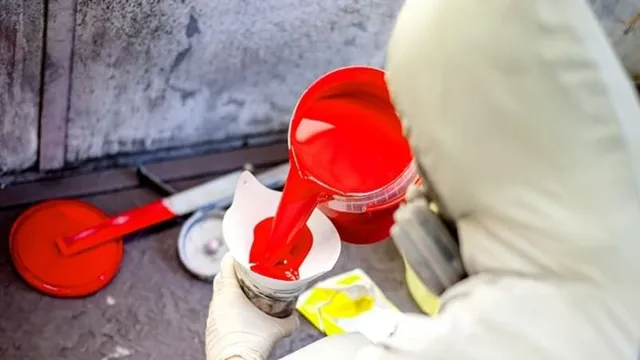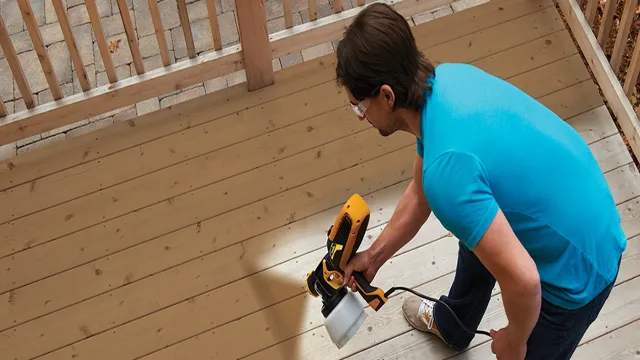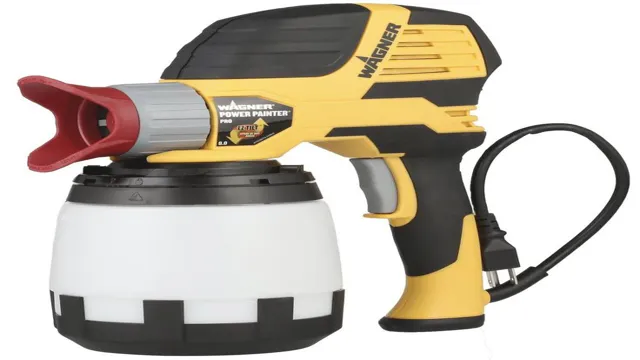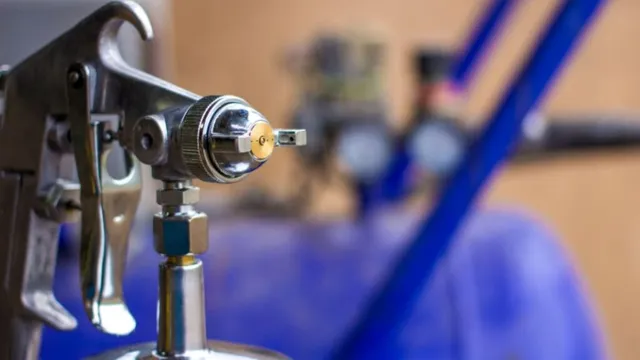Can You Spray Primer with a Paint Sprayer? Tips and Tricks.

Get your painting project done quicker and easier with a paint sprayer. Instead of spending hours painting with a brush or roller, the paint sprayer can make the task more efficient. However, before painting with a paint sprayer, it’s essential to prime the surface.
Priming is necessary for achieving a smooth painting finish and providing a solid base for the paint to stick to. But, how do you prime a surface with a paint sprayer? In this blog, we’ll dive into the steps and provide tips on spraying primer with a paint sprayer. By following these steps, your painting project will be done in no time, and your surfaces will look professionally painted.
What is Primer?
Yes, you can spray primer with a paint sprayer! Primer is a type of paint that is specifically designed to prepare surfaces for the application of a topcoat. It creates a smooth, even surface that helps the topcoat adhere properly and last longer. It’s important to use the right primer for your specific project, as there are different types of primers available for different surfaces and applications.
When it comes to spray painting primer, a paint sprayer can be a great tool to achieve a smooth, even coat. However, it’s important to follow the manufacturer’s instructions for both the primer and the paint sprayer, as there can be specific settings and techniques that will ensure the best possible results. So, if you’re looking to spray primer with a paint sprayer, just make sure you’re choosing the right primer for your project and following the manufacturer’s instructions for both the primer and the spray equipment.
Primer Purpose and Application
Primer is a type of paint or coating that is applied to a surface, usually before the actual paint goes on. The purpose of primer is to prepare the surface for a smoother, more uniform application of paint, and to help the paint adhere better. Primer also helps hide imperfections in the surface, such as cracks or holes.
There are different types of primer for different types of surfaces, such as wood, metal, or drywall. Using the right type of primer for the surface you are painting will help ensure a better, longer-lasting finish. Think of primer as the foundation for your painting project – it provides a strong base for the final coat of paint.
Without a good primer, your paint job may not look as smooth or last as long as it could. So, whether you’re painting a room in your house or a piece of furniture, don’t skip the primer!

Using a Paint Sprayer for Primer
Yes, you can definitely use a paint sprayer for primer. In fact, using a paint sprayer for primer has a number of benefits. A paint sprayer will typically apply primer faster and more evenly than would be possible with a brush or roller.
This means you can complete your primer coat more quickly and with less effort. Additionally, using a paint sprayer can help ensure that you get full coverage, even in tight spaces or on uneven surfaces. When using a paint sprayer for primer, make sure you use a compatible primer that is thin enough to be applied with a sprayer.
You’ll also want to take precautions to avoid overspraying, which can lead to wasted material and a messy workspace. But with a little practice, using a paint sprayer for primer can be a great way to speed up your painting process and achieve a professional-looking finish.
Advantages of Using a Paint Sprayer
When it comes to applying primer to surfaces, using a paint sprayer can be an efficient and cost-effective way to get the job done. One of the main advantages of using a paint sprayer for primer is that it can create a smooth and even coat, which is essential for achieving a flawless finish. Additionally, using a paint sprayer can save time and effort compared to using a traditional brush and roller, especially on larger projects.
The sprayer also allows for easier access to hard-to-reach areas, making it ideal for painting curved or uneven surfaces. Moreover, the sprayer can easily adjust the coverage and thickness of the primer according to the surface being painted. Overall, using a paint sprayer for primer is a great way to achieve professional-looking results with minimal time and effort.
Preparing the Paint Sprayer and Primer
When it comes to painting, using a paint sprayer can save you a lot of time and effort. However, it is important to properly prepare both the paint sprayer and the primer beforehand. Begin by choosing a primer that is compatible with your paint and surface.
Then, mix the primer thoroughly and strain it to remove any impurities. Next, pour the primer into the paint sprayer, making sure to adjust the tip and pressure according to the manufacturer’s instructions. It may take some practice to get the hang of using a paint sprayer, but with patience and persistence, you will be able to achieve a smooth and even coat of primer on your surface.
Remember to keep safety in mind by wearing protective gear and taking necessary precautions to avoid inhaling any harmful fumes. Taking these steps will ensure that your primer adheres properly and provides a good base for your final coat of paint.
Spraying Technique
When it comes to using a paint sprayer for primer, the spraying technique can make all the difference in achieving a professional-looking finish. Primer is essential for providing a smooth and even surface for the topcoat, but it can be challenging to apply evenly with a brush or roller. A paint sprayer allows for a more controlled application, but it’s important to follow the correct spraying technique to avoid uneven coverage or drips.
Start with a slow speed and low pressure, and gradually increase as needed. Hold the sprayer at a consistent distance from the surface, moving side to side and overlapping each pass slightly. It may take some practice to get the hang of it, but once mastered, using a paint sprayer for primer can save time and give a flawless finish.
So next time you’re looking to start a painting project, consider trying out a paint sprayer for your primer application.
Tips for a Successful Spray Primer Job
If you’re looking to use a spray gun for your primer job, the answer is definitely yes! It’s essential to find the right paint gun and correct nozzle size for the job. Once you’ve got the equipment sorted out, make sure you prep the surface properly. Clean the area you’re going to prime and make sure it’s dry before starting.
Use a mask and gloves to protect yourself, too. Keep your sprayer around 6-8 inches away from the surface, moving it slowly and evenly to prevent pooling and get an even coat. Finally, be sure to let the primer dry completely before sanding, painting, or applying another layer.
With the right materials and attention to detail, your spray primer job will turn out perfectly.
Avoiding Common Mistakes
Spray Primer Job When it comes to spray primer job, there are a few common mistakes that you want to avoid. For starters, make sure that the surface you are spraying on is clean and dry. Any dirt or moisture on the surface can interfere with the primer’s adhesion.
It is also crucial to apply the primer in thin, even coats. Spraying too much can cause drips, while not using enough can leave bare spots. Another mistake to avoid is spraying from too far away.
Instead, hold the can at the recommended distance for best results. Finally, make sure to shake the can well before use to ensure an even distribution of the primer. By avoiding these common mistakes, you can achieve a successful spray primer job that will provide a smooth and durable surface for your next painting project.
Maintaining the Paint Sprayer
When it comes to achieving a successful spray primer job, maintaining your paint sprayer is crucial. One of the first things you can do to ensure that your sprayer is ready for your next project is to clean it thoroughly. A dirty paint sprayer can lead to clogging and uneven coverage, which will only result in frustration and wasted time, not to mention wasted paint.
Another tip is to make sure that you use the appropriate types of materials for your sprayer. Using the wrong materials can cause damage to the internal components of the sprayer, leading to expensive repairs or replacements. Additionally, it’s important to inspect your sprayer for wear and tear and replace any broken or damaged parts before beginning your next project.
By following these tips, you can help ensure a smooth and successful spray primer job every time.
Conclusion
In conclusion, asking whether you can spray primer with a paint sprayer is like asking whether you can play baseball with a glove. Sure, you could technically use your hands, but it’s not going to be as effective or efficient. Using a paint sprayer to apply primer will lead to a smoother and more consistent application, saving you time and effort in the long run.
So go ahead, spray away!”
FAQs
What type of spray gun can be used to spray primer?
A paint sprayer with a 1.8mm or larger tip is recommended for spraying primer.
Can you use a regular paint sprayer to apply primer?
Yes, a regular paint sprayer can be used to apply primer as long as it has the appropriate tip size.
What is the best type of primer to use with a paint sprayer?
A high-build primer that dries quickly and can be sanded easily is recommended for use with a paint sprayer.
Do you need to thin primer before spraying it with a paint sprayer?
Yes, most primers need to be thinned before spraying with a paint sprayer. Be sure to check the manufacturer’s instructions for the correct amount of thinning.
Is it necessary to use a primer before painting with a paint sprayer?
Yes, it is recommended to use a primer before painting with a paint sprayer as it helps to seal the surface and provide better adhesion for the paint.
How do you clean a paint sprayer after spraying primer?
To clean a paint sprayer after spraying primer, flush it with a suitable solvent or cleaning agent as per the manufacturer’s instructions.
Can you paint directly over primer sprayed with a paint sprayer?
Yes, once the primer has dried, it can be sanded lightly and then painted directly over with a paint sprayer.



